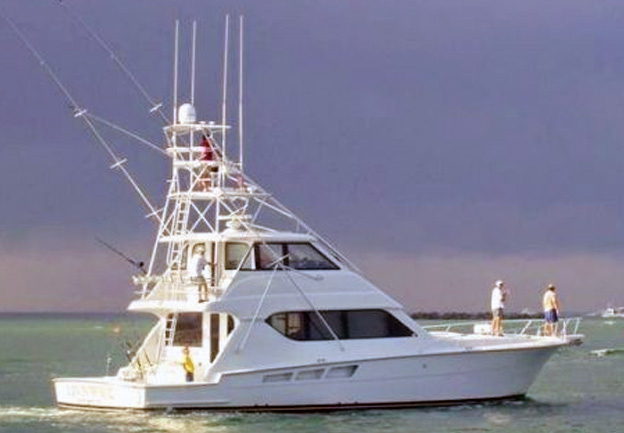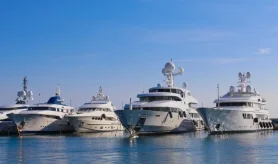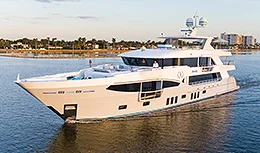- Alaskan Yachts
- Azimut Yachts
- Back Cove Yachts
- Beneteau Yachts
- Benetti Superyachts
- Bertram Yachts
- Boston Whaler
- Broward Yachts
- Buddy Davis Sportfish
- Burger Yachts
- Cabo Yachts
- Catamarans
- Carver Motoryachts
- Center Console
- Chris-Craft Yachts
- Cruisers Yachts
- DeFever Trawlers
- Dufour Sailboats
- Fairline Yachts
- Feadship Yachts
- Ferretti Yachts
- Filippetti Yachts
- Formula Yachts
- Fountaine Pajot Cats
- Grady-White
- Grand Banks Trawlers
- Hargrave Yachts
- Hatteras Yachts
- Hinckley Picnic Boats
- Horizon Yachts
- Hydra-Sports
- Intrepid Boats
- Jarrett Bay Sportfish
- Jeanneau Yachts
- Kadey-Krogen Trawlers
- Lazzara Yachts
- Lekker Boats
- Luhrs Sportfish
- Marlow Yachts
- Maritimo Yachts
- Marquis Yachts
- Mazu Yachts
- McKinna Motoryachts
- Meridian Yachts
- Midnight Express
- MJM Yachts
- Mochi Craft
- Neptunus Motoryachts
- Nordhavn Trawlers
- Nordic Tugs
- Numarine Yachts
- Ocean Alexander Yachts
- Ocean King
- Offshore Yachts
- Outer Reef
- Oyster Sailing Yachts
- Pacific Mariner Yachts
- Palmer Johnson Yachts
65 Hatteras Convertible
Boat Review: 65 Hatteras Convertible

Source: Bob Vollmer, Sea Magazine
The Hatteras 65 convertible is one sportfisher that accomplishes what many builders only promise: a sleek, luxurious boat loaded with all the features that saltwater anglers seek. Its rakish good looks, from the low profile cockpit to its sweeping foredeck and bow pulpit, are like an artist’s rendering of the ideal sportfishing cruiser.
Designer Jack Hargrave first introduced the Hatteras 65 Convertible four years ago. For 1991, Hatteras updated this classic and made it even more luxurious. Its redesigned interior now is finished with lighter woods, rounded cabinetry, elegant overhead spotlights and floor accent lighting.
The new 65 gives cruising fans a spacious three stateroom, three head accommodation plan and a boat loaded with amenities. Cedar-lined lockers, whirlpool jet tub and shower, a central vacuum system, composite countertops, wet bar, U-shaped galley layout and air conditioning are among its long list of features.
Fishermen, too, will find a lot to like about the 65, starting with its huge, 175 square foot, 13 foot long cockpit. Its 38 inch transom door makes it easy to bring large catches aboard. In addition, a molded-in fish box in the transom coaming, additional fish boxes in the sole, a bait preparation station, live bait well, stainless steel refrigerator/freezer and optional cockpit controls round out the battle station.
A special Hatteras feature, the Hargrave Modified-V Hull, provides a sharp entry and broad flare to keep everyone aboard dry. The V-shape flattens somewhat at the chines for responsiveness in a variety of sea conditions.
Our test boat, provided and piloted by Jerry Schei, owner of Western Yacht Sales in Seattle, was equipped with two major options: a modified open galley layout and an enclosed flying bridge.
No matter how completely a boat is appointed, its performance is what ultimately determines its success or failure. Happily, the 65 is in the success category.
On our boat test, we moved the vessel away from the dock with ease against a light southwesterly rain in a classic maneuver – stern first. With its twin diesels loafing at idle, there was virtually no sound on the flying bridge. With engines in gear, it seemed we were moving with fine control at well under the speed limit. This was due to the “Troll Mode”: a system that allows a controlled release of pressure in the transmission, creating a slippage that slows propeller rotation. With the boat’s large engines and the propellers in gear, we could otherwise have created an undesirable wake in these confined waters.
Once clear of local traffic, we eased the throttle forward out of the Troll Mode, to 1,350 rpm and 15 knots. At that speed, the boat consumes about 30 gallons per hour. According to Hatteras tests, running at 30 to 31 knots at 2,300 rpm with full fuel and water aboard, the boat consumes 152 gallons of fuel per hour. Its top speed is 31 knots.
The smooth flow of water and near vibration-free ride is testimony to the design of the Hargrave Modified-V Hull. Contributing to its smooth performance is an air induction system that forces air under the hull. This develops a cushion of air between the propellers and the hull, greatly reducing noise and vibration.
As the boat accelerated flawlessly, we began a series of S-curves, followed by a 360 degree turn. Steering was smooth and highly responsive; like handling a well-designed sports car on a smooth stretch of highway. Making the 360 degree turn did require a fair amount of room, probably because of the boat’s long, deep keel.
Performance Plus comfort
Along with responsive performance, the 65 offers accommodations designed to please anglers and dyed-in-the wool cruisers alike.
The enclosed flying bridge layout has ample space for entertaining. A full-length settee to port and another settee for two provide all the comfort of an elegant pilothouse. The area features white ash wood trim and cabinetry with a soft luster finish.
During inclement weather, it would be nice to have been able to reach the flying bridge from the saloon. Climbing the ladder to the flying bridge is not difficult, but carrying items up the ladder, especially underway in rough seas, could be awkward.
The flying bridge instrument panel layout is convenient and all gauges are easily readable by the helmsman. Lexan windows that open add light and ventilation, and a climate control system allows minute temperature adjustments. Three Lexan windshields, each with its own wiper, provide excellent forward visibility and a panoramic view.
An aft steering station is available to port for anglers working a big fish. A small refrigerator/freezer and a seat with stowage underneath is positioned to starboard. This is the best spot aboard to watch what’s going on in the cockpit.
On the starboard deck, a single fill port is provided for all three diesel fuel tanks, and it is thoughtfully placed on the opposite side of the boat from the water fill, to avert potential contamination problems. Port and starboard sides have 240 and 120 volt shore power connections and automatic cord retractors, for convenience.
A fiberglass console with a sliding rack for lures is positioned in the cockpit, starboard of the saloon entrance.
The 18 foot beam provides 250 square feet of space in the main saloon, where light reflects softly off the white headliner, thick matching carpet and large, L-shaped settee. The white ash bulkheads, galley cabinets and U-shaped dinette offer contrast and a feeling of warmth.
The adjacent galley has a white simulated marble counter surrounding a four-burner range. A microwave/convection oven is directly above.
All of the amenities a seagoing chef could want are provided, including refrigerator/freezer, dishwater, icemaker and garbage disposal.
Starboard of the companionway entrance is a U-shaped dinette that seats six. An entertainment center with VCR and large television, mounted in the bulkhead above the dinette, is visible from the saloon.
The companionway leading from the saloon features plexiglass grabrails, matching carpet and white grasscloth-covered bulk-heads. By lifting the stairway, there is access to a utility area with washer/dryer, another freezer and more stowage.
A crew stateroom is positioned to starboard, featuring two single berths at right angles and additional access to the utility area. To port, the guest stateroom has twin berths. A queen-size berth is optional.
Forward, the master stateroom has one private head with shower, cedar-lined closets, television, air conditioning and an overhead hatch for light and ventilation.
Access to the engine room is through an insulated cockpit hatch. Unfortunately, this is the only entrance and exit to the engine room. While this situation is not unique to Hatteras, the 65 and other vessels of similar design could and should be equipped with a secondary exit for added safety.
Inside, the engine compartment offers full standing headroom. Ample lighting and ventilation are provided, and air conditioning is available. Port and starboard DC circuit panels are mounted just inside, at eye level, and correspond to dual battery banks. Onan generators are accessible abaft each main engine.
The boat’s dual Detroit Diesel 16V-92TA engines are positioned for ease of service, however, getting to the outboard side requires some agility.
AC power distribution panels are located at the forward end of the engine room, and all circuits are properly labeled. All electrical and mechanical installations appear to be accomplished with reasonable access in a well-insulated, yet confined area.
As we headed back to the berth on Lake Union, it was obvious this new Hatteras 65 was everything any cruising fisherman could want – and perhaps a little more.



